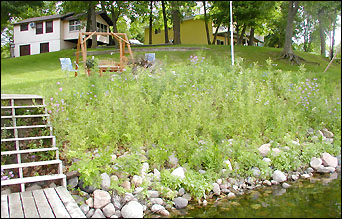Lakescape halts erosion on Koronis property
Lil and Rick, who live in White Bear Lake, have summered on Lake Koronis near Bugbee Hive Resort for 27 years. While the shoreline on their property had gradually eroded over the years, in 2001 a severe thunderstorm washed out about five feet of the steep bank, leaving the soil exposed. The threat of more erosion was imminent because there was little plant life left on the bank to anchor it.
Erosion is a serious problem in area lakes and streams, according to Greg Berg, a shoreland specialist with the Stearns County Soil and Water Conservation District. When soil is washed into the watershed, it carries nutrients that can add to algae blooms, creating slimy green water. The added soil just isn't needed in the watershed, he added.
 Lil and Rick considered several options that would stop the erosion and still fit their financial limits. They looked at other properties on the lake - most of which had grass extending to the shoreline, which does little to halt erosion or runoff, according to Berg - to get ideas for their own backyard.
Lil and Rick considered several options that would stop the erosion and still fit their financial limits. They looked at other properties on the lake - most of which had grass extending to the shoreline, which does little to halt erosion or runoff, according to Berg - to get ideas for their own backyard.
Pictured is the landscape at Lil Lopez's Lake Koronis cabin. She enjoys the flowers in her erosion barrier and that it is maintenance free.
Some of the options they considered were lining the shore with rocks, building a concrete retaining wall, and terracing the bank. They never considered lakescaping until their son Jeff, an environmental science major, encouraged them to contact the DNR to learn more about lakescaping. Jeff pointed out that technical and financial assistance could be available from several government agencies.
Working with the Stearns County Soil and Water Conservation District, the Lopezes were able to plan a lakescape that would control erosion and provide wildlife habitats. As an added bonus, the lakescape is beautiful and virtually maintenance-free, said Lil.
Willow stakes driven deep into the soil act as anchors, their sturdy root systems spreading out to support the entire area. The roots of native shrubs - including wild roses, sumac, and dogwoods - also help anchor the bank while providing visual interest. Native grasses and wildflowers slow the water runoff from the steep bank leading from the house to the lake. The grasses also filter the runoff by absorbing nutrients before they make it to the lake.
Before the project was started, Lil was skeptical about working with a government agency. She worried about not getting to make a lot of her own decisions. She soon learned that her concerns were unfounded. Her family was encouraged to participate during every step of the project. For instance, Lil and Rick didn't want tall trees to block their view, so woody shrubs were chosen instead. When it was time to choose which plants would be used, Lil was delighted when she was allowed to pick from a list with dozens of plants.
Much of the work - including grading the bank, driving willow stakes, and planting shrubs - for the lakescape project was done in the fall of 2002. In 2003, wildflowers and grasses were planted. The entire area was overseeded with annual grasses, which grew quickly, to lessen the erosion problem while other plants got established.
This year, Lil is thrilled with the appearance of her lakescape. The purple blooms of the wild phlox were lovely in the spring, she said, and she's looking forward to seeing the wild roses bloom this year.
Animals have already discovered the area, too, said Lil. Birds that Lil has never seen before now frequent her yard, and fish seem to enjoy lingering in the shade of the native plants on the shore.
As time passes, the lakescape will evolve with plants multiplying and maturing. Already Lil has noticed that some of the wildflowers have seeded themselves in the backyard beyond the boundaries of the lakescape. She will allow the plants to spread as far as they can.
Any large landscaping project can be expensive, according to Lil, and lakescapes are no exception. The Lopez project cost about $4,000 to restore 60 feet of shoreline. A grant from the USDA through the Stearns County Soil and Water Conservation District paid for 75 percent of the project materials and labor, and technical advice and planning was free.
Berg would like to see more lakescaping on Koronis and Rice. He believes more lakescapes will be developed as residents become aware that money - which sometimes goes unused from year to year - is available for small erosion control projects. In addition, grant money for large projects is available through the USDA.
Lakescaping was definitely the right thing for the Lopezes to do, said Berg. With the heavy rains that pummeled the lakeshore this spring, Berg believes the Lopezes would have a bigger problem now if the lakescape hadn't already been established. Now, their shoreline should be very stable and will continue to improve as time passes.
For more information on lakescaping or to apply for a grant for an erosion control project, contact Berg at 320-251-7800 extension 3.
Contact the author at editor@paynesvillepress.com • Return to News Menu
Home | Marketplace | Community